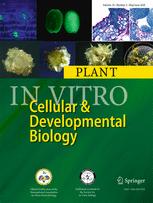Ver ítem
- xmlui.general.dspace_homeCentros Regionales y EEAsCentro Regional Entre RíosEEA ConcordiaArtículos científicosxmlui.ArtifactBrowser.ItemViewer.trail
- Inicio
- Centros Regionales y EEAs
- Centro Regional Entre Ríos
- EEA Concordia
- Artículos científicos
- Ver ítem
Assessing the effects of basal media on the in vitro propagation and nutritional status of Eucalyptus dunnii Maiden
Resumen
In tissue culture, essential aspects of growth and development can be modulated by managing mineral nutrition and growth regulators. Therefore, basal medium selection is one of the key factors for success with this technique since the nutritional status of tissue cultures relies on it. Although Murashige and Skoog (MS), JADS, and woody plant medium (WPM) media are among the most common basal media used for the in vitro propagation of eucalypts, they have
[ver mas...]
In tissue culture, essential aspects of growth and development can be modulated by managing mineral nutrition and growth regulators. Therefore, basal medium selection is one of the key factors for success with this technique since the nutritional status of tissue cultures relies on it. Although Murashige and Skoog (MS), JADS, and woody plant medium (WPM) media are among the most common basal media used for the in vitro propagation of eucalypts, they have shown limited success for use in Eucalyptus dunnii micropropagation, where excessive callus formation, hyperhydricity, and chlorosis are frequent issues. These morpho-physiological responses could be related to different nutritional conditions provided by each media, showing that none of them was competent for E. dunnii micropropagation. To prevent these problems, a modified version of a novel basal medium for E. dunnii (EDMm), based on chemical analysis of E. dunnii young stump shoots was developed. The morpho-physiological responses and mineral nutrient contents of four E. dunnii clones cultured in EDMm, JADS, MS, and WPM basal media were assessed. Multivariate analysis suggested that Cu, Fe, Mn, and Zn concentrations in tissues, all of which are at higher concentrations in EDMm medium than the other media, were associated to higher rooting rates. On the other hand, higher K and S concentrations were related to higher multiplication and growth rates. The results showed that all basal media tested support axillary shoot multiplication, but only the shoots grown in EDMm media presented no Fe chlorosis or oxidation symptoms and showed higher rooting rates.
[Cerrar]

Autor
Oberschelp, Gustavo Pedro Javier;
Gonçalves, Antônio Natal;
Fuente
In vitro cellular & developmental bology - Plant 52 (1) : 28–37. (February 2016)
Fecha
2016-02
ISSN
1054-5476
1475-2689
1475-2689
Formato
pdf
Tipo de documento
artículo
Palabras Claves
Derechos de acceso
Restringido
 Excepto donde se diga explicitamente, este item se publica bajo la siguiente descripción: Creative Commons Attribution-NonCommercial-ShareAlike 2.5 Unported (CC BY-NC-SA 2.5)
Excepto donde se diga explicitamente, este item se publica bajo la siguiente descripción: Creative Commons Attribution-NonCommercial-ShareAlike 2.5 Unported (CC BY-NC-SA 2.5)

